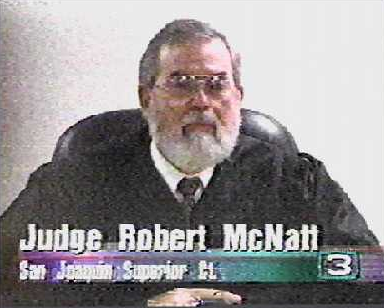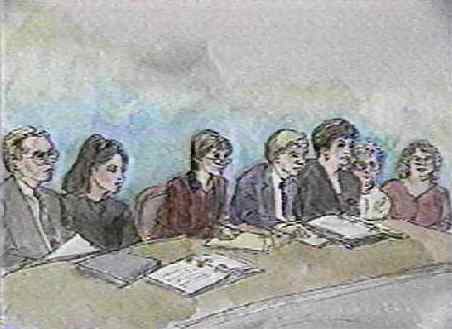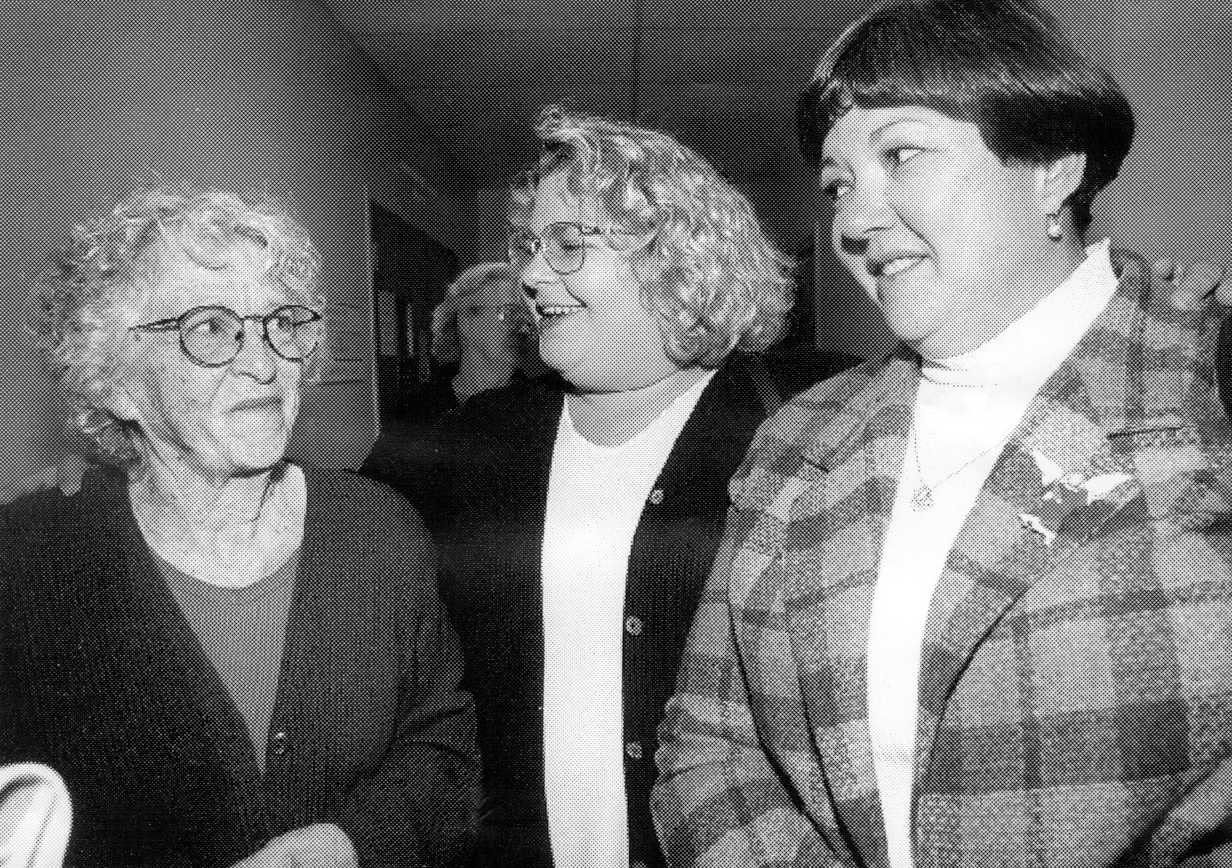The Cost of the Call (Part Two):
Reflections in Conjunction with the 5th Anniversary of the Wendland Victory
Tomorrow is the fifth anniversary of the California Supreme Court’s decision in Conservatorship of Wendland.
So how ironic is it that tonightof all nights I happened to run into the trial court judge, Bob W. McNatt?

I hadn’t seen him for a couple of years and was genuinely glad to encounter him. I would not describe Judge McNatt as a brilliant jurist, but he is a decent, honorable man who is committed to his work. Throughout the Wendland case, I knew that he was doing his very best to be thorough, accurate, and in compliance with the letter of the law. During the trial, he knew that any ruling he made would be appealed, and I always felt that he did his best to provide the parties with his rationale so that the appellate court would have a decent record to review when making its decision.
Both of us look a lot older now, as the pictures I have included here confirm.
We chatted for a few moments about our current work. And he reminded me that we are inextricably intertwined in the history books.
Both of us agreed that we could not do it again.

When you are in the midst of a great deal of stress, it is common not to realize the toll it is taking upon you and those around you. The situation must be dealt with. Contemplating how you are feeling about it frequently is a luxury you just don’t have time for until much later. You just put one foot in front of the other and deal with it.
So it was for nearly the entire six years that I represented Florence Wendland and Rebekah Vinson. I had been handed the case by the managing partner at the firm. After I watched the videotape showing Robert responding to his physical therapists at Lodi Memorial Hospital, read his medical records up to that date, and looked at the state of the law as of that date ((There was no legal precedent because the California courts had never heard or decided such a case.)), I knew that I had been thrust into something I was totally unprepared for.
I also knew it was a case I could not lose. The stakes were simply too high.
I didn’t have a clue how I was going to go about preparing for the trial, much less secure a victory for my clients. All I knew was that I could not let my clients down. Thankfully, at the beginning it seemed like only the folks living in the county in which the trial took place were watching. Then it was the entire state . . . eventually, the whole nation, and then the world. We were interviewed by the major daily newspaper in Tokyo and there were several pieces written about the case by the London Times.

But I didn’t have the luxury of time to analyze my feelings. I just put one foot in front of the other. I spent many, many nights doing what I’m doing right now . . . surfing the ‘Net while watching television. I couldn’t sleep. I couldn’t stop thinking about the case, my clients, what was at stake. Potential legal strategies haunted me in the wee hours.
Ms. Clairol became my new best friend. “See these gray hairs? I owe fifty percent of them to Robert Wendland, and the other fifty percent to my kids and husband,” I would joke.
The realization that I had been called to handled the case came slowly, gradually. Only after the first few skirmishes did I see that this had been my case from its inception and my handling of it was preordained. I came to feel very much the way pastors and priests describe their sense of being “called” into the ministry.
Of course, I didn’t talk to anybody about it except for a couple of my closest Christian friends (Wesley J. Smith and Dana Cody) and my pastors, for fear people would think me either a bigger egomaniac than they already presume lawyers are — or a complete lunatic.
I certainly did not tell anyone that, for the entirety of those six years, I felt the weight of Robert Wendland’s very life on my shoulders. I carried it around as surely as if I had carried his physical body on my back. I lived day in and day out with the sure knowledge that if I abandoned my clients, Robert would die. No other lawyer was crazy enough to step into the battle that was raging and take over representation of my clients. No other lawyer was crazy enough to handle the case on his/her “own time,” i.e., after working 50 or 60 hours per week in a law firm on other cases — which is how I handled the appeals. No other lawyer wanted to be associated with the case — branded, as it were, a rabid “right-to-lifer,” as Ron Cranford called me and my clients from the witness stand as the other attorneys snickered at counsel table.
Nope, this baby was all mine.
So it came as no real shock when, on the second day of trial after the managing partner at my firm (who was supposed to be “lead counsel” at the trial) had completely botched his direct examination of Rose Wendland, my clients came to me and told me that they wanted me to be the lead counsel. They wanted him off the case, having lost any faith they once had in him. Instead of blowing up, as I feared he would when I told him, he was relieved. He practically skipped down the hallway, undoubtedly on his way home to enjoy a good stiff drink and celebrate his good fortune.
Proof yet again that this was my case and I had been called to litigate it.
The trial dragged on for weeks. Eventually, though, it occurred to me that Rose Wendland simply could not win because she had not carried the evidentiary burden earlier assigned to her by Judge McNatt. I floated the idea around the office. Nobody thought that bringing a motion to end the trial at that point was a winning strategy. But I did, so I stayed up all night writing the brief. We waited until the end of the day to argue the motion . . . the courthouse was closing up around us and the sun had long since set, but we remained in Judge McNatt’s courtroom arguing while the media camped out in the hallway waiting for word. I was praying that the motion would be granted, thereby bringing about the end of the trial — and eliminating any need for me to make the opening statement the managing partner had “deferred” (one of the dumbest trial strategies in the history of jurisprudence) or call a single witness to the stand.
I was told later that while I was in court arguing the motion, the partners at my law firm were back at the office laughing about my strategy — and at me for putting so much effort into it. They were utterly convinced it would not work.
But the Holy Spirit was in the courtroom that day. It assured my clients the victory. After all, I was called to handle this case and the Holy Spirit was not going to abandon me then — or at any time thereafter.
What I hadn’t yet realized — and would not come to fully comprehend or appreciate for a few more years — is that the Holy Spirit had been guiding me toward that moment for many, many years. ((More on this at a future date.))

Do I look exhausted in that photo? I should! That photo was snapped as my clients and I walked out of the courtroom, having just heard Judge McNatt’s ruling, and were bombarded by questions from the media. My husband was there that day, so he got to hear the arguments and be there when my clients won. He was thrilled and extremely proud.
I remember that all I wanted to do was go home and tell my kids — who were 10 and 6 years old at the time — that the trial was over and yes, we could put the Christmas tree up that weekend. It was December 9, 1997. And there was going to be a Christmas at our house after all because Mama was not going to be in trial through the holidays.
Click here to read Part Three.


Comments are closed.